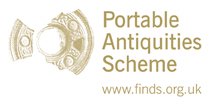Server check!
You are on the training database
Buttons and studs
Example = GLO-585315, NMS-160212
Date = 2100-800 BC
Distribution = Britain
Comment = The Isleham hoard, found near Cambridge, contained a number of looped buttons and tanged studs. It is thought that these items could have been attached to horse and wagon gear. A variety of different types of buttons have been discovered especially from the Late Bronze Age.
Ribbed Buttons
Example:
Date: c.1,020-800 BC (Ewart Park metalwork phase)
Distribution: Southern England and Wales (isolated finds in Durham)
Description: These buttons usually are circular with a broad loop, a thick rim and a broad central depression containing an annular rib and a central spike. Varying between 2.0 and 2.6 cm in diameter, they have been identified by O'Connor as almost deserving of the name 'Llangwyllog buttons' after the hoard that contained the most examples of this type.
Double-Looped Buttons
Example:
Date: c.1,020-800 BC (Ewart Park metalwork phase)
Distribution: Thames Valley area and Midlands
Description: Similar to the ribbed buttons, save for their namesake, the double-loop, which sets them apart. There is an example of a perforated double-looped button from the Welby hoard that appears to be unique.
Tanged Convex Studs
Example:
Date: c.1,140-800 BC (Wilburton to Ewart Park metalwork phase)
Distribution: Southern England
Description: Studs differ from buttons through the presence of a small tang in place of a loop, but are otherwise very similar in size and shape.
Tanged Conical Studs
Example:
Date: c.1,140-800 BC (Wilburton to Ewart Park metalwork phase)
Distribution: Southern Central England
Description: Similar to the convex studs, except for the shape, which is more elongated and protrudes up to 1cm further than their close relatives.


